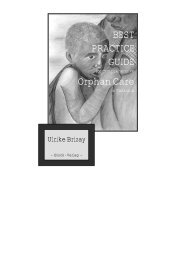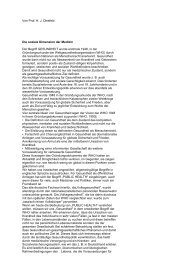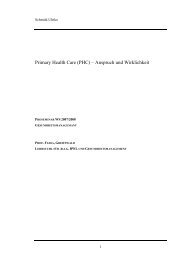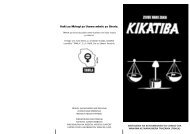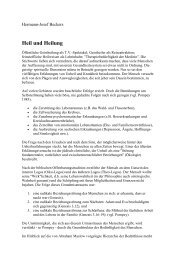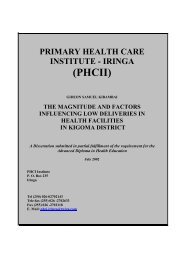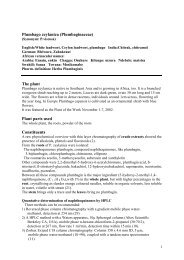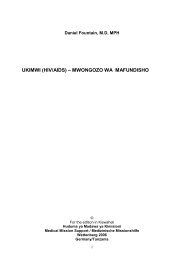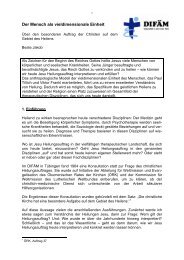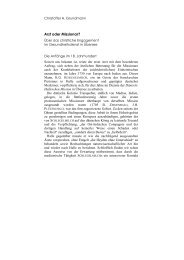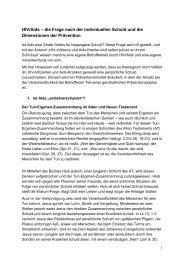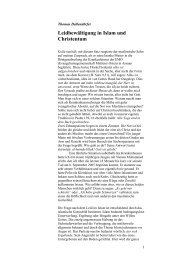Tabebuia impetiginosa, Tabebuia avellanedae ... - MMH/MMS
Tabebuia impetiginosa, Tabebuia avellanedae ... - MMH/MMS
Tabebuia impetiginosa, Tabebuia avellanedae ... - MMH/MMS
You also want an ePaper? Increase the reach of your titles
YUMPU automatically turns print PDFs into web optimized ePapers that Google loves.
One can order Lapacho tea: http// Green Life Company<br />
Results of experimental studies<br />
Effects of the aqueous extract<br />
A survey investigation was done with the aqueous extract of T. <strong>avellanedae</strong> inner<br />
bark about antinociceptive and antiedematogenic effects in mice and in rats.<br />
Injuries were produced by acetic acid or formalin in mice. In both cases the<br />
nociception was reduced around 50 %. Naloxone could not reverse the effect, but<br />
caffeine did it.<br />
In a rat oedema test the inhibition value of the aqueous extract was about<br />
12.9 %. Authors conclude that this antinociceptive effect is associated with the<br />
adenosine system (19).<br />
In an anti-CD-driven lymphocyte proliferation assay (MTT-assay) the aqueous<br />
extract of <strong>Tabebuia</strong> inner bark inhibited the lymphocyte proliferation dose<br />
dependently. In a whole blood T-cell assay the extract inhibited the ConA stimulated<br />
T-cell proliferation, dose dependently. Concentrated extracts were not toxic for<br />
lymphocytes, as verified by a trypan blue exclusion assay.<br />
The inhibitory effects were only observed in aqueous but not in ethanol plant extracts.<br />
The authors conclude that these facts are not mediated by the lead component<br />
lapachone (3).<br />
The water extract of Brazilian T. <strong>avellanedae</strong> contains two iridoids, a new<br />
phenylethanoid glycoside and further twelve known compounds. They inhibited the<br />
nitric oxide production in the lipopolysaccharide activated macrophage-like J774.1<br />
cell (2).<br />
Antioxidant property of the volatile oil<br />
The antioxidant activity of the volatiles was tested in two different assays. They<br />
inhibited the formation of conjugated diene hydroperoxides at a concentration of<br />
1000 µg/ml and the oxidation of hexenal for 40 days at a level of 5 µg/ml. The<br />
authors compare this result with the well-known antioxidants alpha-tocopherol and<br />
butylated hydroxytoluene (23).<br />
Antibacterial and antifungal activity<br />
The antibacterial activity of fl-lapachone, 3-hydroxy-fl-N-lapachone and alphalapachone<br />
was tested on methicillin-resistant and vancomycin-resistant<br />
Staphylococcus strains. The MIC values of fl-lapachone were 8, 4, and 64 µg/ml,<br />
respectively. But there was no bactericidal activity for all compounds at 512 µg/ml<br />
(24).<br />
In a paper disk diffusion assay anthraquinone-2-carboxylic acid was toxic against<br />
Clostridium paraputrificum with 1µg/disk, while a 100µg/disk was needed for<br />
moderate growth inhibition by lapachol. These two substances inhibited E. coli and<br />
Clostridium perfringens at 100µg/disks. According to the structure-activity<br />
relationship the C-2 position of 1,4-naphthochinones may play an important role (22).<br />
These and related substances show similar effects against Helicobacter pylori,<br />
compared with commonly used antibiotics like tetracyclines.<br />
The authors conclude that these plant substances merit further studies as Helicobacter<br />
pylori eradicating medicines (21).<br />
In a test line with fourteen Paraquajan plants, used in traditional medicine for the<br />
treatment of skin diseases aqueous, dichloromethane, and methanol extracts were<br />
tested in vitro against 11 fungal strains. By the agar disk diffusion methods the<br />
aqueous and methanol extracts showed the highest activity (26).<br />
3



